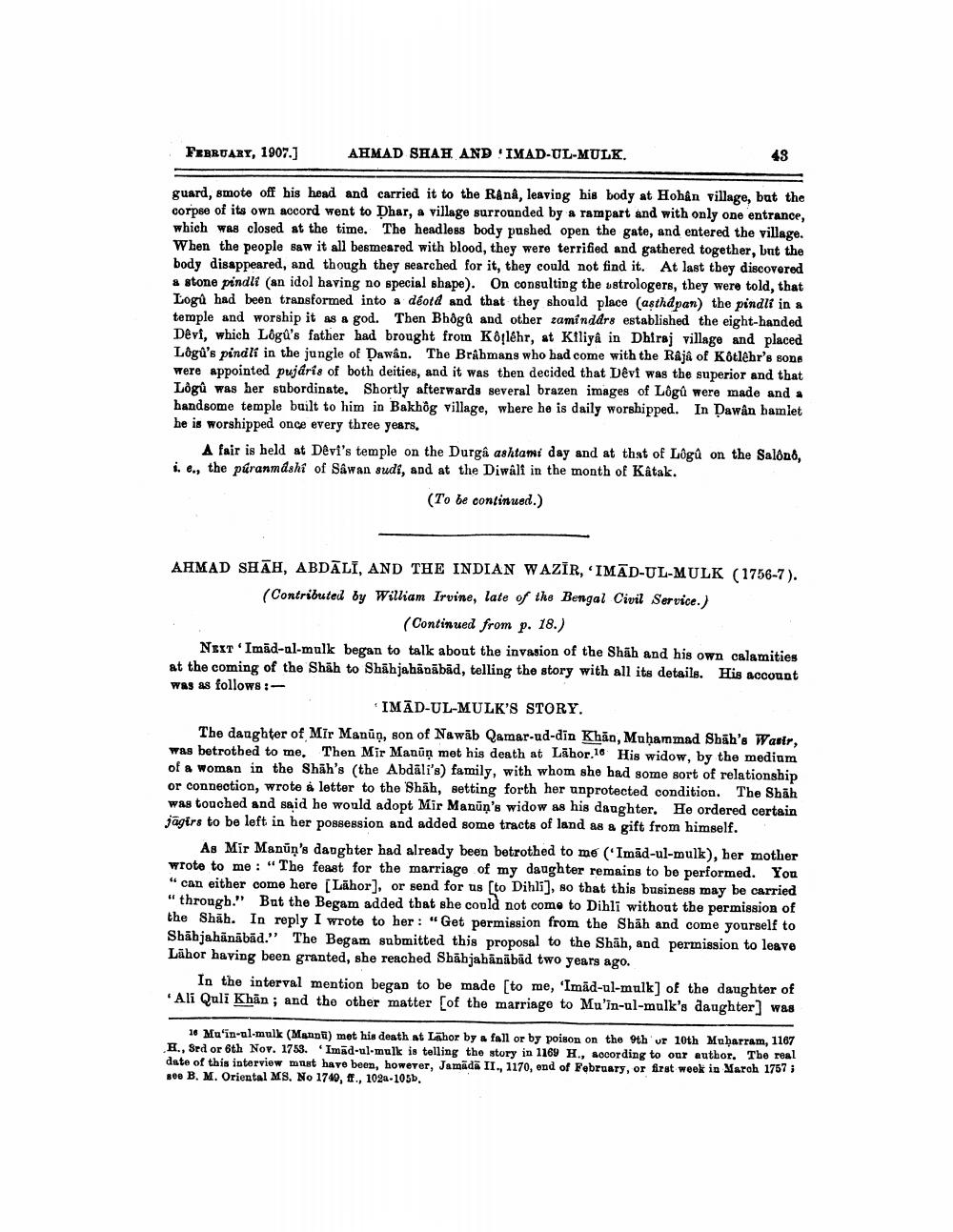________________
FEBRUARY, 1907.)
AHMAD SHAH. AND IMAD-UL-MULK.
43
guard, smote off his head and carried it to the Ranâ, leaving his body at Hohận Village, but the corpse of its own accord went to Dhar, a village surrounded by a rampart and with only one entrance, which was closed at the time. The headless body pushed open the gate, and entered the village. When the people saw it all besmeared with blood, they were terrified and gathered together, unt the body disappeared, and though they searched for it, they could not find it. At last they discovered & stone pindli (an idol having no special shape). On consulting the astrologers, they were told, that Logú had been transformed into a déotd and that they should place (asthapan) the pindli in a temple and worship it as a god. Then Bhögû and other zamínddrs established the eight-handed Dêvi, which Lögu's father had brought from Kolehr, at Kiliya in Dhiraj village and placed Lögû's pindli in the jungle of Dawân. The Brahmans who had come with the Raja of Kotlehr's sons were appointed pujárís of both deities, and it was then decided that Devi was the superior and that Lògû was her subordinate. Shortly afterwards several brazen images of Lögû were made and a handsome temple built to him in Bakhög village, where he is daily worshipped. In Dawân hamlet he is worshipped once every three years.
A fair is held at Devi's temple on the Durga ashtami day and at that of Lögû on the Salono, 1. e., the püranmdshi of SÂwan sudi, and at the Diwalt in the month of Katak.
(To be continued.)
AHMAD SHAH, ABDĀLI, AND THE INDIAN WAZĪR, IMĀD-UL-MULK (1756-7). (Contributed by William Irvine, late of the Bengal Civil Service.)
(Continued from p. 18.) NEIT Imid-al-mulk began to talk about the invasion of the Shah and his own calamities at the coming of the Shah to Shahjahadābād, telling the story with all its details. His account was as follows:
IMĀD-UL-MULK'S STORY. The daughter of Mir Manūņ, son of Nawāb Qamar-ud-din Khān, Muhammad Shāh's Wasir, was betrotbed to me. Then Mir Manūņ met his death at Lāhor.16 His widow, by the medium of a woman in the Shah's (the Abdāli's) family, with whom she had some sort of relationship or connection, wrote a letter to the Shāh, setting forth her unprotected condition. The Shah was touched and said he would adopt Mir Manūņ's widow as his daughter. He ordered certain jagirs to be left in her possession and added some tracts of land as a gift from himself.
As Mir Manūņ's daughter had already been betrothed to me ('Imád-ul-mulk), her mother wrote to me: “The feast for the marriage of my daughter remains to be performed. You " can either come here (Lühor], or send for us (to Dihli], so that this business may be carried "through." But the Begam added that she could not come to Dihli without the permission of the Shāh. In reply I wrote to her : "Get permission from the Shāh and come yourself to Shāhjahanabad." The Begam submitted this proposal to the Shāh, and permission to leave Lūhor having been granted, she reached Sbābjabānābād two years ago.
In the interval mention began to be made [to me, 'Imid-ul-mulk] of the daughter of Ali Quli Khān; and the other matter [of the marriage to Mulin-ul-mulk's daughter] was
18 Mu'in-ul-mulk (Manu) met his death at Lähor by a fall or by poison on the 9th ur 10th Muharram, 1167 H., Sed or 6th Nov. 1753. Imid-ul-mulk is telling the story in 1169 H., according to our author. The real date of this interview must have been, however, Jamida II., 1170, ond of February, or first week in March 1757 i Bee B. M. Oriental MS. No 1740, ff., 102-105b.




